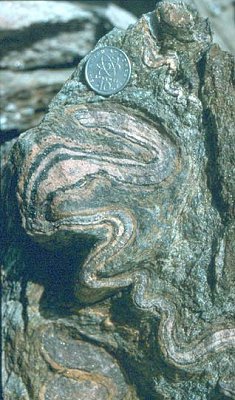![]()
Folds are amongst the most common tectonic structures found in rocks, and can make some of the most spectacular features. They can occur on all scales and in all environments.
 In
areas of active mountain building, as for example here in the front ranges of
the Himalayas in Pakistan (right), folds bulge up the landscape. The upward
moving parts (called antiforms) create hills while the areas that have gone
down relative to the hills (called synforms) collect detritus eroded from the
surrounding countryside. A common misconception is that rocks can only fold
when they are nearly molten. These outcrops tell a different story. Rocks like
these limestones can fold even at the Earth's surface - provided they are given
enough time. A fold like this could take a hundred thousand years to grow. But
if the rocks were pushed together more quickly - they could break - making faults.
In
areas of active mountain building, as for example here in the front ranges of
the Himalayas in Pakistan (right), folds bulge up the landscape. The upward
moving parts (called antiforms) create hills while the areas that have gone
down relative to the hills (called synforms) collect detritus eroded from the
surrounding countryside. A common misconception is that rocks can only fold
when they are nearly molten. These outcrops tell a different story. Rocks like
these limestones can fold even at the Earth's surface - provided they are given
enough time. A fold like this could take a hundred thousand years to grow. But
if the rocks were pushed together more quickly - they could break - making faults.

Folds can occur on all scales. These folds from the island of Syros only have a wavelength of a few millimetres. To make folds the rocks must have a mechanical layering. If they are homogeneous they will just squash together without folding. A stiff layer (more viscous) will fold if embedded in weaker (less viscous) material. You can try this yourself - using different types of plasticene. You can find out more about how rocks fold by clicking here. Or you can return to the front menu.